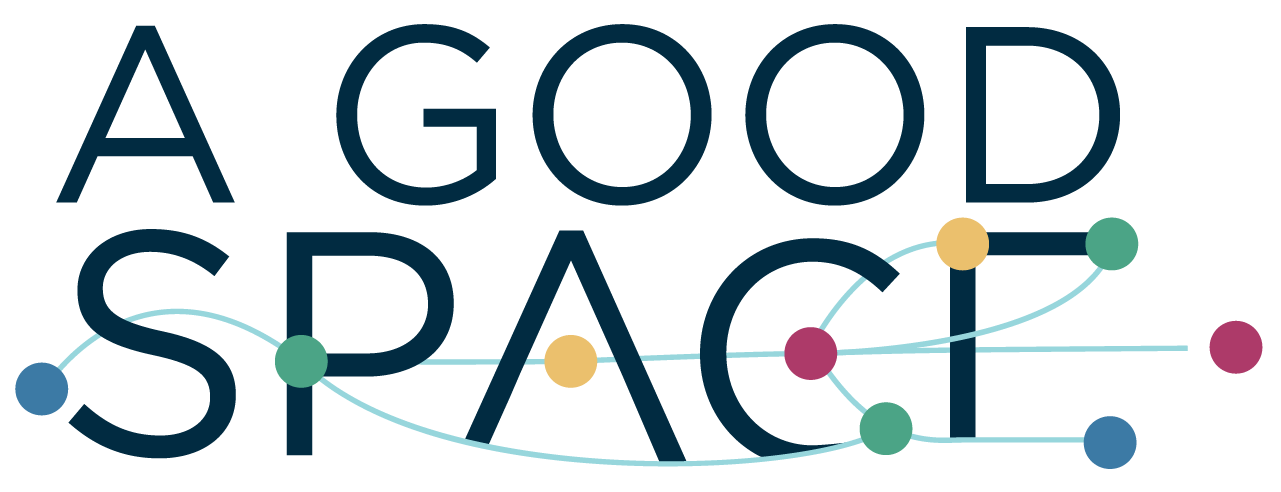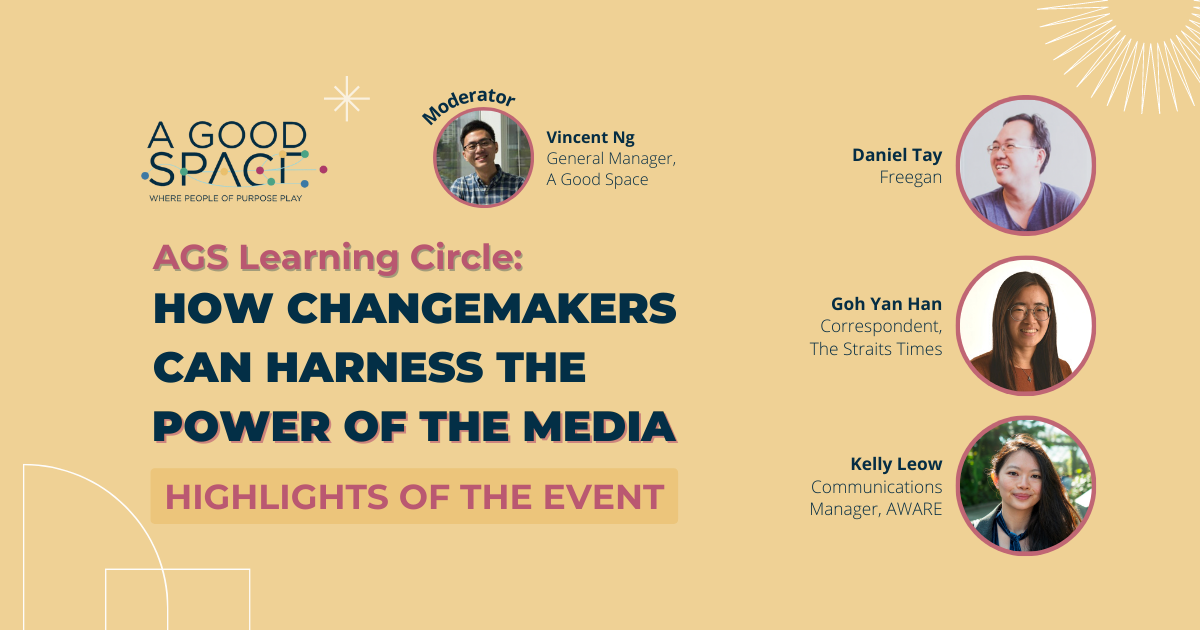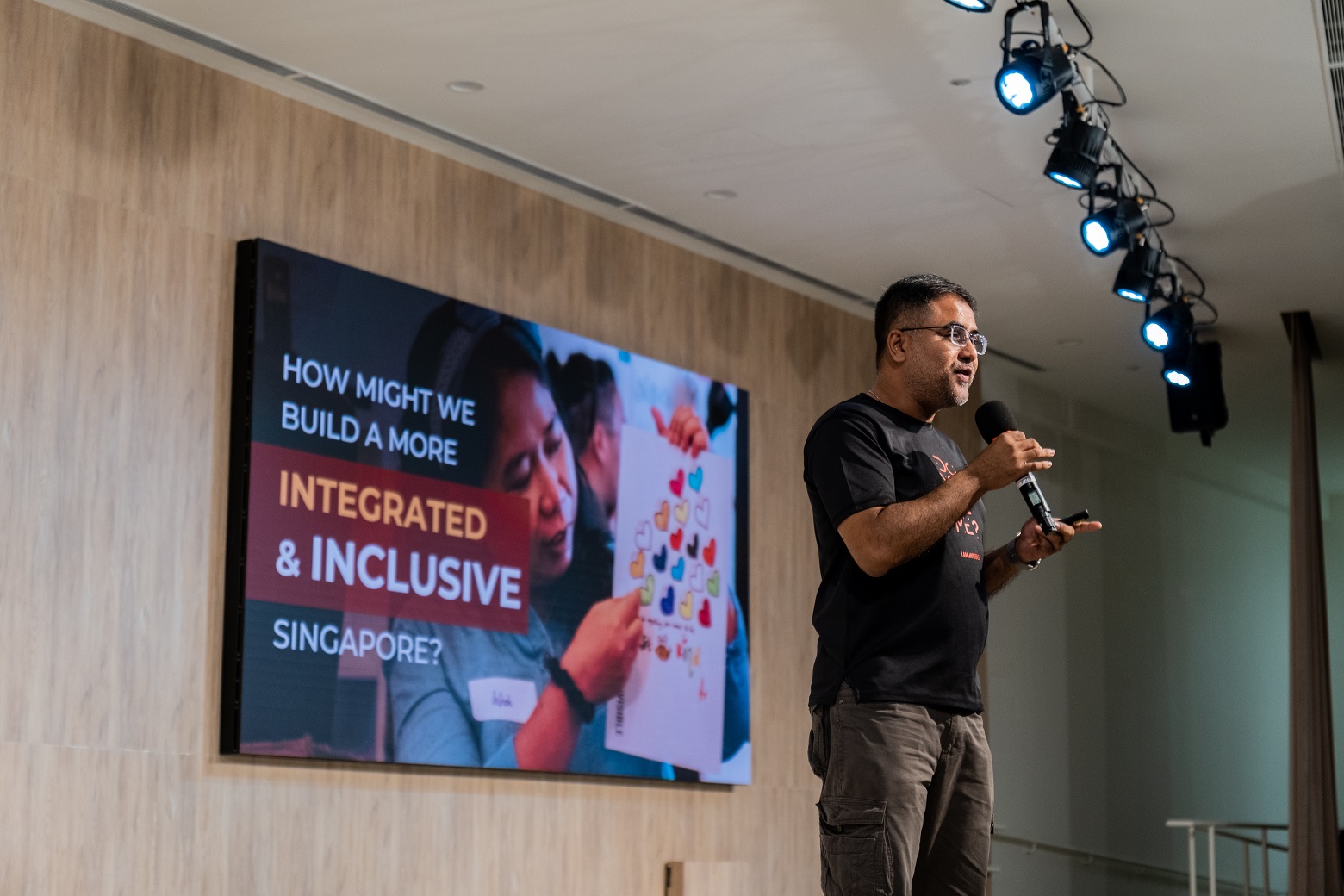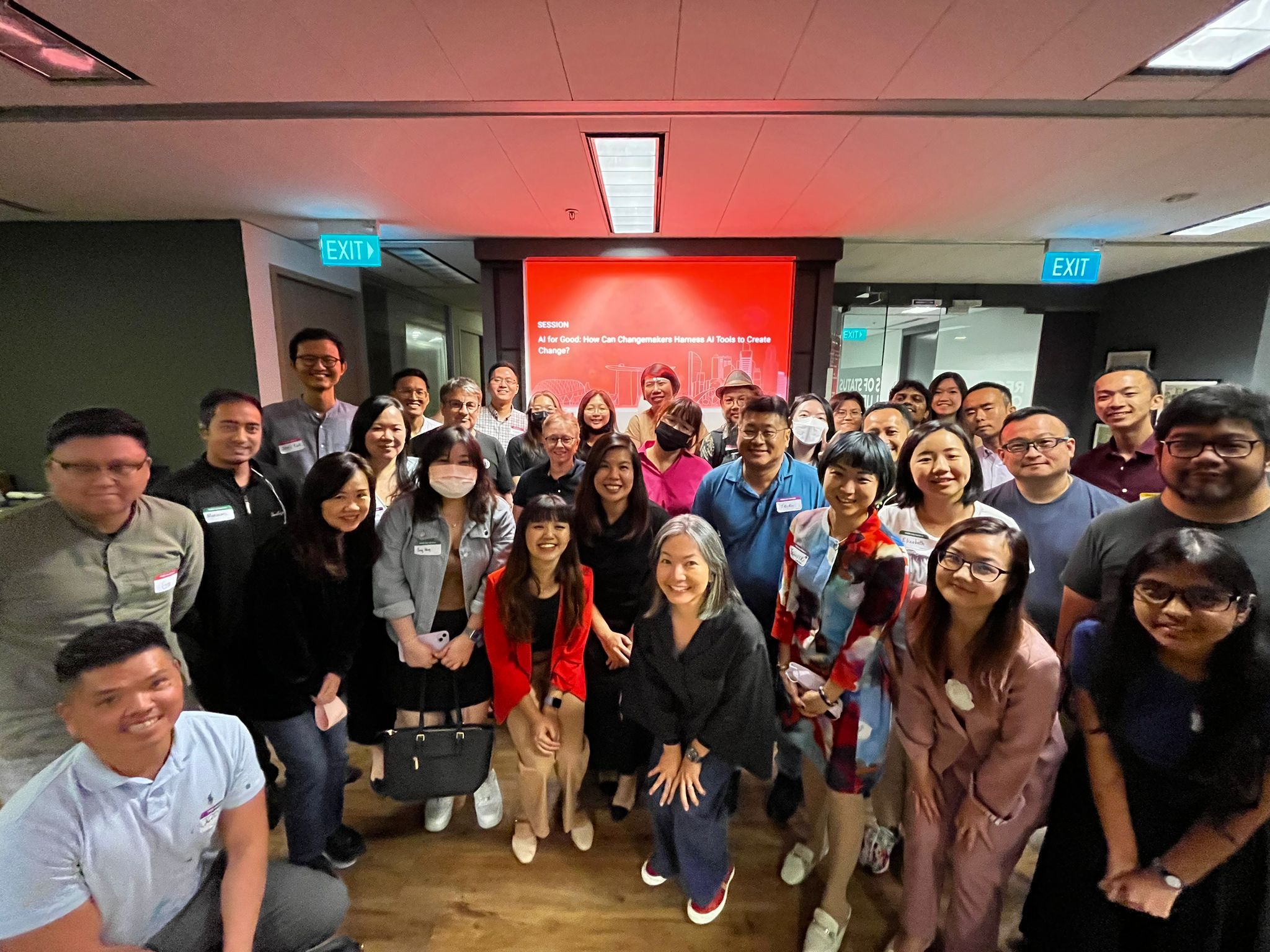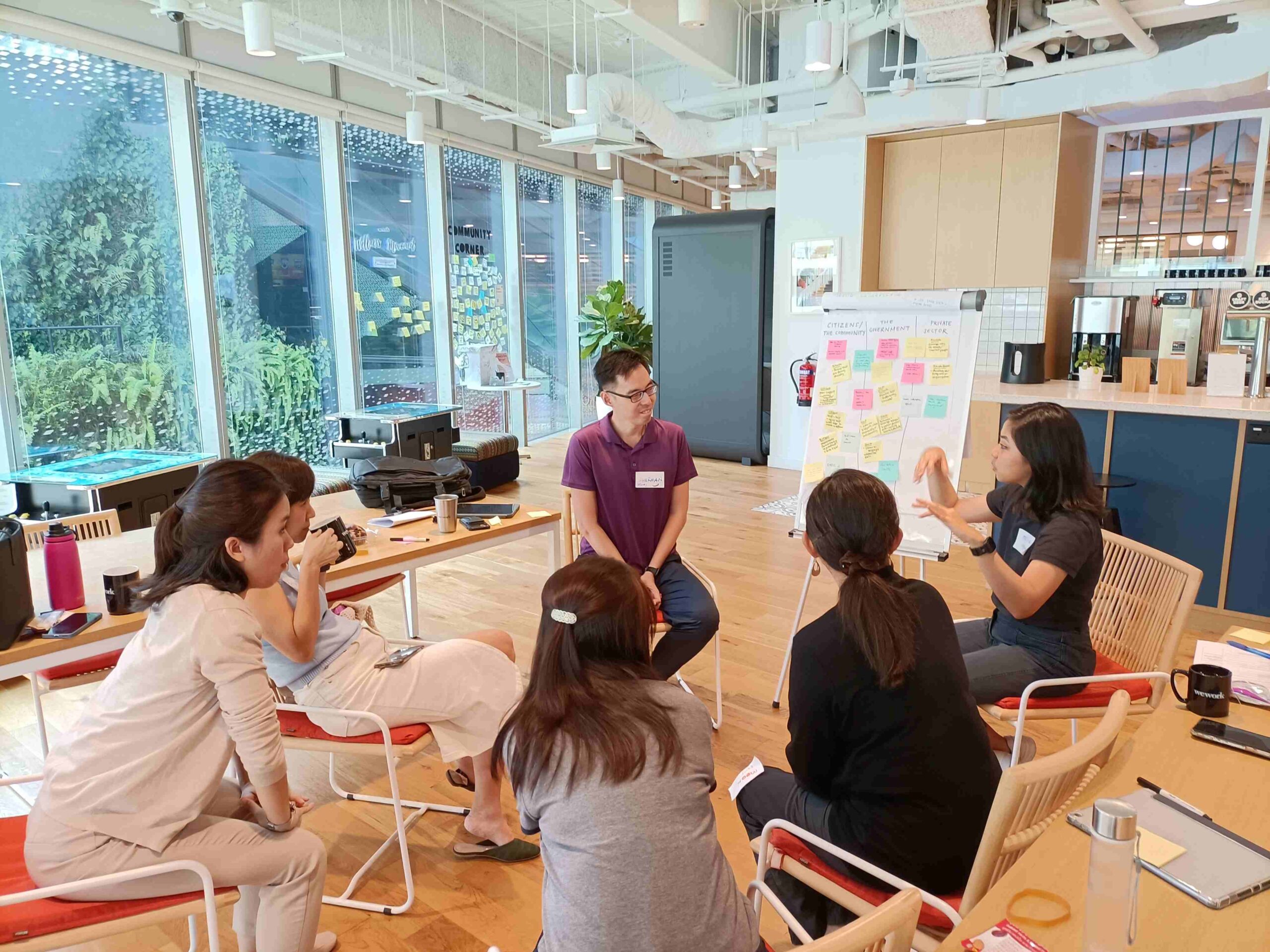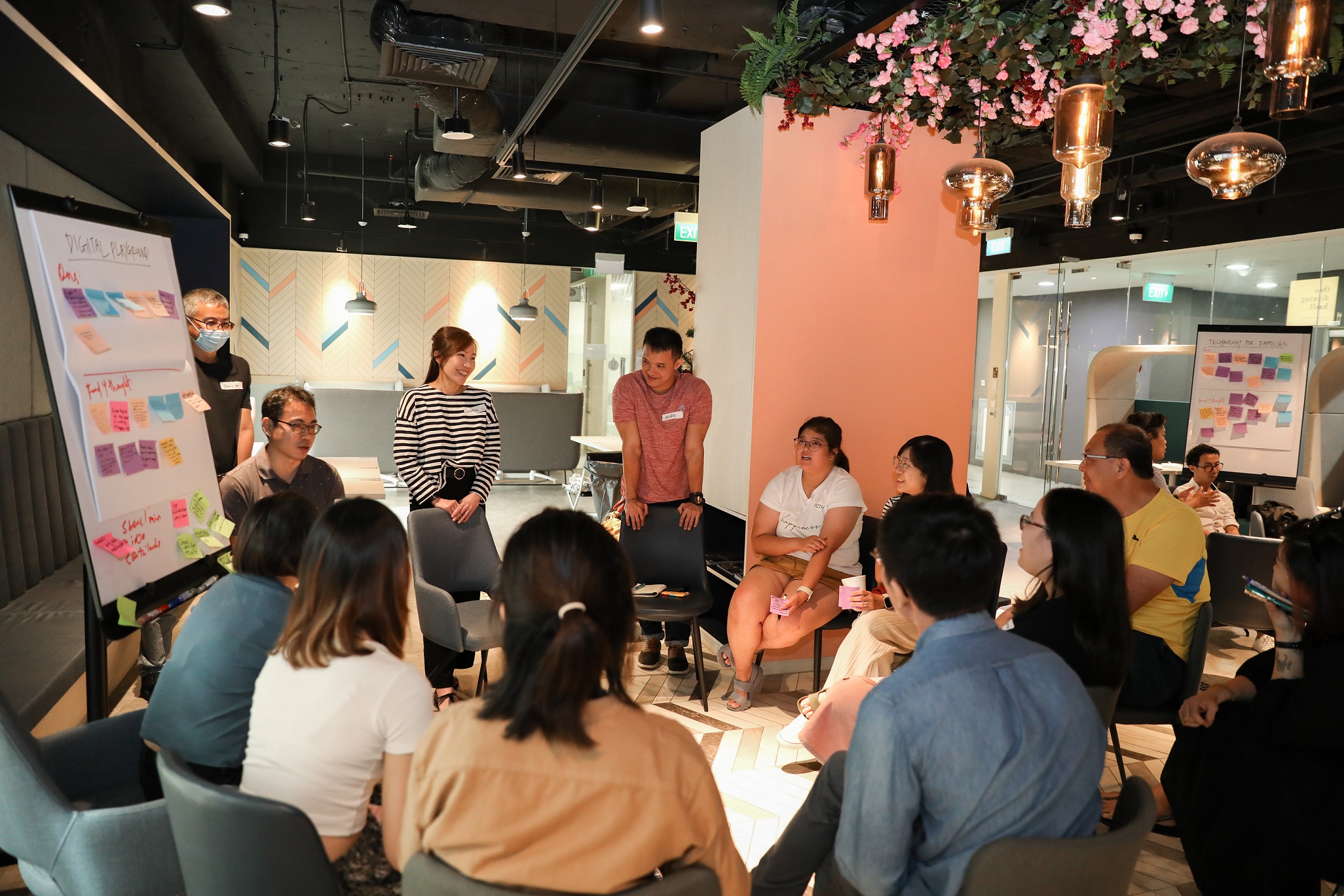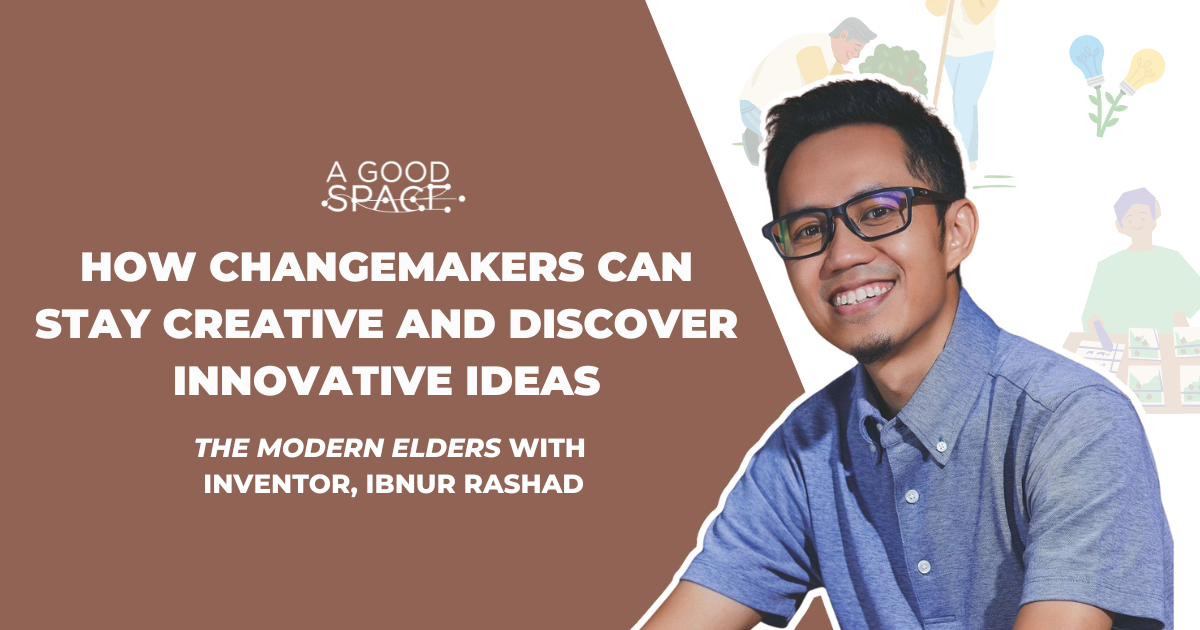Last month, we organised a Learning Circle about media engagement.
The media can be a very powerful ally to help changemakers find volunteers, raise funds and create positive social change. Yet, many changemakers (such as those in our community) find it challenging to do so effectively.
How do we tell an attractive story? How do we work with journalists to ensure stories, particularly those of people in vulnerable communities, are told with authenticity and nuance? What do we need to look out for?
That’s why we organised this learning circle to explore these questions and build collective wisdom! We got to hear what our 3 panellists had to say on these topics, and our participants also shared their own stories from their experiences with the media.
Our panel consisted of A Good Space member and newsmaker, Daniel Tay, to speak from a ground-up initiative and changemaker perspective, Kelly Leow as AWARE Singapore’s communications manager to speak from an NGO perspective and Goh Yan Han as a correspondent at The Straits Times to share her experiences working at a large scale media publication.
What the power of the media could look like for your changemaking initiative
We started the learning circle by first discussing tangible ways the media has been an ally in creating positive change.
The panellists agreed that the media is a great tool to amplify your message and bring awareness to under-served communities or lesser-known issues.
Daniel shared how his freegan cause was not well-known in Singapore before 2017. However, after two features by CNA and TODAY Online, the attention on freeganism became national. As a result, his Facebook group, Freegan in Singapore jumped from 300 members to its current 9,900 in a matter of months!
I had a separate interview with him before the event where he shared more of his own media tips and tricks – read that article here!
When asked to recall stories she’s written that created positive social change, Yan Han highlighted Straits Times’ Causes Week, a yearly section of the newspaper that shines a light on various individuals and groups that do good in Singapore. This has provided a great platform to bring awareness to lesser known initiatives and groups that are trying to help the community.
Follow-ups with previously featured social service groups have shown that these groups have recruited more volunteers, or have connected with people who have requested their services!
Kelly also shared that AWARE’s aim when they engage the media is to shift narratives around topics which could also garner support for policy advocacy.
AWARE released a report on caregiving and its gendered nature, highlighting how caregiving presented significant financial burdens on top of psychological ones. This arguably started more conversations about the topic, as it featured more commonly in forum letters and on social media. This attention made these issues of caregiving more mainstream and has translated into people like MP Carrie Tan proposing a CareFare Income Supplement in Parliament last year!
Similarly, Daniel recognised that his 2018 efforts to reduce food waste aligned with what the government was advocating. Now, a few years later, MP Louis Ng is proposing a Good Samaritan Food Donation Bill through a Private Member’s Bill in Parliament to reduce the nation’s food waste problem.
What makes an attractive media pitch
Now that you know what the media could do for you, how exactly do you make it happen?
And why, as Yan Han posed during the session; should a publication, given their limited space and manpower, report on your story over someone else’s?
The panel discussion revealed three main elements of an attractive pitch:
1. Bring something new to the table!
The key to getting more eyeballs is ensuring that it is novel – is it a new program, recommendation or idea? Are you serving a niche group? What distinguishes your initiative from previous or existing initiatives?
Identify what makes your story stand out from the rest, and state it clearly at the start of your pitch. Yan Han even suggests putting it in your email subject line!
2. Human faces help to tell a story better
Another way to have a compelling pitch is by attaching a human face to the story. For someone like Daniel, whose social cause is tied to his identity as a freegan, doing a changemaker-centred feature would be beneficial in amplifying both his personal brand and social cause.
However, even if the focus of media pitch is an organisation or initiative, it would still be beneficial to have someone of note to feature in the story. This could be someone spearheading the initiative, an expert to give their opinion, a volunteer or a profile that demonstrates the tangible social impact of your work.
This would clearly illustrate how your initiative is really needed in society, and subsequently why it deserves more attention. A bonus is being able to include a profile in the pitch who is willing to shoot photos and a video because this would help to tell the story better!
If you have a profile who would like to remain anonymous, it is best to include that in your pitch as well!
3. Timeliness is key
Another aspect of a good story that was brought up was timeliness.
Take the RVHS incident for example; the pitches received on youth mental health might not have done well on an ordinary day, but given the gravity of the situation, Yan Han talked about how The Straits Times ran several follow-up pieces on the topic in order to give limelight to the issue.
It also helps to keep an eye out for major annual events like International Womens’ Day or National Day. Doing so would allow you to prepare for the news coverage that usually comes with these designated events, which usually have a different theme every year.
Kelly also talked about how “determining timeliness also involves trying to take the temperature of the conversation on any given issue. What level of discourse is taking place – is it advanced and nuanced, or still fairly simplistic?” Especially with issues related to gender, honing an awareness of what topics are people concerned about can be critical to gauge how a story will be received by an audience.
This also impacts how journalists write their stories. She brought up how the #MeToo movement has led to an improvement in the quality of journalism around issues of sexual harrassment, and a noticeable decrease in victim-blaming questions.
Even if it is not the most timely topic, if the other aspects of the pitch are present and written well, journalists could still try to pitch it to their bosses and they can decide which day of the week they can publish itn. Yan Han mentioned here that Monday and Sunday prints usually feature stories or packages that are done in advance.
If not, you could also look to other outlets like Rice Media and Mothership that also have a sizeable readership!
Getting the media’s attention
Ensuring your pitch is clear is a great first step – this ensures that any journalist who reads it will immediately be able to identify why it’s worth covering, your key message and your main objective (gain volunteers, fundraise etc.).
However, some participants asked if there was more they could do. Our panellists shared a few other tips to increase your chances of getting noticed by a publication.
Yan Han said that emailing reporters directly is your best bet. The Straits Times makes this easy by having writers’ emails publicly available on their website. This might be challenging for other news publications that do not give out this information readily.
Of the many pitches Yan Han receives on a daily basis, many are not relevant to what she covers in social affairs. Take note of which journalists cover what topics and areas. Do the research to ensure you are intentional with who you’re reaching out to. Not only does this increase the likelihood that the reporter you pitch to is more keen on your story, it also puts some salience in journalists’ minds for future stories.
That way, if Yan Han wanted to write about persons with disabilities, for example, she wouldn’t have to start from scratch as she would already know someone to contact.
It always helps ensure that your offer is clear and concise; state clearly if it’s an exclusive that you’re offering to this media outlet alone. Yan Han said short and simple media pitches tend to be the most effective – and avoid using crazy fonts!
Taking steps to make the job easier for journalists goes a long way in pushing your story up an editor’s priority list.
Ensuring care and authenticity when spotlighting vulnerable and sensitive stories
The fast-paced nature of news cycles can sometimes affect the sensitivity with which journalists handle a story. Another topic raised was how initiatives that work with people from vulnerable communities usually face the additional challenge of getting their beneficiaries to feel comfortable sharing their stories.
As an organisation, there are steps you can take to ensure the safety of your profiles.
Kelly’s guideline is that you should not say yes to every media opportunity. In fact, AWARE turns down interviews quite often, especially if the angle that a reporter writes about runs the risk of mis-characterizing topics, which tends to be the case for stories regarding sexual violence.
Having facilitated many of these interviews, AWARE has developed an agreement that they now send to all media interviews with survivors. On top of this, they have also put together a media guide for anyone speaking about their experiences in partnership with AWARE.
Kelly has kindly shared these resources with us. If you would like to access them, email us a request at admin@agoodspace.org being sure to state your intended use. Please keep in mind that these documents are not meant for public circulation.
Yan Han and our other participants also shared media guides that have helped them! These resources can be found on the Padlet that we used during the breakout rooms which you can access here.
Kelly also suggested exploring levels of anonymity that allow the message to get across and tell a detailed and compelling story without revealing their identity. Of course, this takes more work to ensure that.
Different outlets of coverage offer varying levels of flexibility such as the amount of control you have over a story once it has been published. Blogs are more flexible and can take down stories if needed.
From the reporter’s perspective, Yan Han believes that everyone should have a level of empathy, whether or not profiles have a comms person there to facilitate. Being a journalist is one thing, but to her, being a human is much more important.
She remembers how senior reporters briefed her on how to feature stories of persons from vulnerable communities. This includes the responsibility of asking and double-checking facts with these profiles and making sure they feel comfortable sharing, especially for sensitive information.
Social Impact: post event survey
Since the inception of this learning circle, we have committed to ensuring that whatever program we organised benefits changemakers in their initiatives.
We were thus heartened to see that this particular learning circle allowed participants to learn something new and feel more confident in engaging the media for their changemaking projects!
In the post-event survey, one participant shared:
This topic speaks to me and the questions and inputs were also helpful in shaping my perspectives and understanding of how I can do better in regards to media engagement. There were practical tips and also stories of successful media stories that managed to shed light on invisible issues [...] Thank you panellists for your generous sharing of knowledge!
Want to be updated whenever we post an article, on top of getting some exclusive ideas, events and opportunities to create social change? Or when we organise Learning Circles just like this one? Sign up for our mailing list here!
We have also made a recording of the session available on our Youtube Channel which you can watch here!

Sin Melia
Melia is a Digital Marketing Trainee at A Good Space. She is a big fan of mother nature, tiger balm and food tiktok. You can probably find her somewhere over-analysing a TV show or K-drama.
